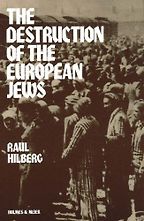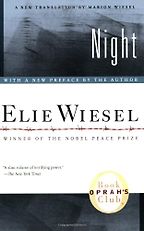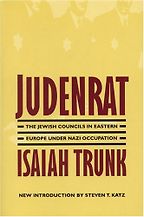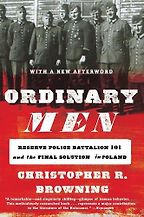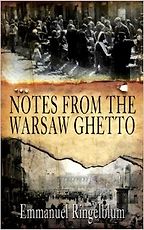You’ve picked books for us to help understand the Holocaust, and your first choice is The Destruction of the European Jews, the landmark study of the Holocaust by Raul Hilberg. This was first published half a century ago, and now runs to three volumes. Can you tell me about it?
What happened is that there had been prior books about the Holocaust, for example by a Frenchman named Léon Poliakov, and they were important first steps. But the real professionalisation of the discipline, a tremendous change in the recognition of the importance of the Holocaust, came from the publication of Raul Hilberg’s The Destruction of the European Jews in 1960-1.
He had great difficulty getting it published, but, once it did get published, people saw that it was a subject of enormous historic importance. Also, the way he carried it out – Hilberg, as a young man, had helped do some of the research for the trials at Nuremberg and elsewhere. So, his close knowledge of the huge collection of German documents that had been brought together for those trials just changed the whole landscape. And Raul continued to work on this book for the next 50 years – he only passed away two years ago – and it grew and grew into the present three-volume edition.
And why did he have trouble getting it published?
At that time people did not seem to feel that the Holocaust was a subject that would have a readership, that there was a lot of interest in it. Today we’re so well aware, it’s so much part of the public discourse and the public conversation, but at that time it was a subject that was little talked about in public. The survivors didn’t talk, and the victimisers didn’t talk, so there was a general agreement to push it to the side – both in scholarship and in general conversation.
Is there anything you would point to in the book as being of special significance?
Yes, his method. He was a student at Columbia University, of political science. So his method is that of a political scientist. Also, more importantly, what Raul did was emphasise the German side of the Holocaust. He didn’t study Jewish documents that closely, or look at the behaviour of the victims, at resistance, or anything like that. He went right to the documents he knew from the war trials, and he concentrated on the way the mass murder was organised by the German state, by the Nazis.
He had an eye especially for the issues of bureaucracy and technology, which he thought were the decisive factors that made this a new kind of major crime. What was special here was the use of modern organisational techniques, of which he was a student, to carry out this mass murder.
And no one had focused on that before?
Not the way he did. He traced how an order would start in one central location, and how it would be passed to another location, and the order would then be activated by a third group somewhere else, and how the bureaucrats were crucial to organising logistics, supplies, the whole logic of the enterprise. That was really his focus and he did it with great genius.
The second book on your list of Holocaust books is Night, a short but extremely powerful book by Elie Wiesel.
This was published by Elie Wiesel and now is probably the best known memoir that has been written about the experience of the death camps. Elie Wiesel was a young boy of 14 when his tiny city, a place called Sighet, mostly Jewish, in what was then the Romania-Hungary borderland, was overrun. You have to remember that until 1944, Hungarian Jewry had been spared the most extreme forms of Nazi violence. But in 44 the situation changed and the Nazis essentially took over much of the organisation of the Jewish population in Hungary. They came into his little town, the shtetl, and they took him and his family. He went to Auschwitz, where his father died. But he survived the war, miraculously.
Then, in the 1950s, he wrote a memoir in Yiddish. It was a very long memoir, too long, and at that time he was living in Paris. He was with some French intellectuals who told him to shorten the volume and to publish a very watered down or limited version in French. Which he did – and the rest is history. It started to be read widely, and it continues to have an enormous impact all over the world. For example, a few years ago in Chicago they chose it as the book of the year that everybody in all the schools read. Also, Oprah Winfrey picked his book, the new translation, for her book club recently. So I would say of all the books that people read about the Holocaust, besides The Diary of Anne Frank, the most famous memoir is by Elie Wiesel.
What do you think makes it so good?
I think the way the personal scenes are described, the telling scene of his father’s death, the characters he is able to draw and portray and this strange twilight life that people lived. All that has enormous emotional power. And he has the craft; he is a novelist and, unlike many memoirs (which are all important and all have information and all shed light), this has a literary kind of quality. He is able to bring to the focus of the reader a deep emotional power, and something also of the mysteriousness of what happened in the camps. There was something here that really reached the limits of human experience.
“There was something here that really reached the limits of human experience”
I should add there are other important memoirs. The other person who deserves to be mentioned is the great Italian novelist and memoirist Primo Levi. Primo Levi’s books are also extraordinarily important. They are, along with Elie Wiesel’s, the most important record we have of first-person survivor memoirs of the camps. Like Elie Wiesel, Primo Levi has great power. It is very sparse, very minimalist, very, very straight, but very powerful material.
Next on your list of Holocaust books is Isaiah Trunk’s Judenrat, about the Jewish councils in the ghettos.
There is always a discussion and emphasis in films and in various kinds of public conversation about the role of the Germans: What did Hitler order? Why was Hitler obsessed with the Jews? Why did the Third Reich do what it did in the way of anti-Semitism? What was the logic of their racial policy? Why did they create death camps, Einsatzgruppen [see below] and ghettos? But the story is only partially a German story. The victims of the tragedy are the Jews and, therefore, it’s a crucial thing in studying the Holocaust to be able to see the response of the victims.
Now, this comes in many places and in many forms and one of the most controversial was in the ghettos. The ghettos lasted from early 1940, when the first ghetto was enclosed, till the last ghetto, the Lodz ghetto, was dismantled in August of ’44. And there were hundreds of ghettos spread all over Europe. So for five years, millions of Jews lived and died in these enclosed spaces, and to some degree they had the ability to control aspects of their life. The Germans would give an order, a work order, food requirements, issues about health, deportations, whatever it was, and it was the Jews themselves who had to pass these orders on and implement them to a large degree. Now the people who were in power to do that were the members of Jewish councils. One of the first things the Nazis did when they established a ghetto was to establish a Jewish council – big ghettos had bigger councils, small ghettos also had councils. The Nazis directly appointed the leaders of the ghetto councils and they were the crucial mediators between the German overlord, German policies and the Jewish people.
Now after the war, there was tremendous debate about their role, about how they acted, about the morality of some of them, about the fate of many of them. It became especially heated during the Eichmann trial in the early 1960s in Israel, when Hannah Arendt published her book Eichmann in Jerusalem, which is still widely read and very well known. She essentially accused them of being collaborators, and said that had there been no Jewish councils, had there been no Jewish leadership, more Jews would have survived, there would have been less mass murder. So this subject is at the very centre of the study of the Holocaust. And Isaiah Trunk, who is a survivor, undertook this study of the various councils and investigated the question of collaboration and of cowardice, of heroism, of support for resistance or lack of support. And his book has become one of the really great classics of Jewish Holocaust literature.
And what does he conclude?
The bottom line is that firstly, the councils had very, very limited influence, very limited autonomy or freedom. Secondly, especially early on, they were largely unaware of what was happening: the Nazis took extraordinary measures to try to mislead them and to keep them ignorant of the genocidal plan that had been formulated. Thirdly, that even had the councils not existed, there would have been no difference. There were people in the council who saved their own lives, who tried to exploit the situation, who were not always moral paragons. But the bottom line of the evaluation of this behaviour is that it really made no difference. The Nazis were so intent, so obsessed with freeing the world of Jews, of committing genocide, that the policies and practices of the Jewish councils were not a major factor in the outcome. So it’s a very important book. If people want to know about the Jewish side of the tragedy, this is a fundamental book they have to read.
On to the next book on your list of Holocaust books which is Ordinary Men: Reserve Police Battalion 101 and the Final Solution in Poland. This book is presumably looking at the issue of how ordinary people came to carry out such atrocities?
This was a book written by Christopher Browning who now teaches at the University of North Carolina. Chris found a collection of documents that were testimonies given at a trial of a group of German police and they talk about their role in the murder of eastern European Jewry. One needs to know that with the invasion of Russia, in the summer of 1941, the Nazis organised a new form of violence, and they called them Einsatzgruppen. There were four groups of men. They were not volunteers, they were assigned to these units. The largest group was a thousand men and there were three slightly smaller units, a total of 3,000 men. And their orders were very simple – to go in right on the heels of the Wehrmacht [the German army], as the Russians retreated and the Nazi army moved forward.
They were to go into the large towns first and then the smaller communities, round up all the Jews and murder them. Initially, the order seems to have been for Jewish men, but very soon after, on the direct order of Heinrich Himmler, it turned to the killing of women and children as well. These groups went literally from town to town, rounded up the Jews and either shot them or put them in the synagogue and set it ablaze. Or, for example, as they did in Vilnius in Lithuania, they marched them outside the city, to the wooded areas, made them dig large trenches, lined them up, shot them, then the next group had to go in, get shot, lie down on the first group, and slowly you have a pyramid effect of bodies on bodies. Then it would be covered over. So this murder – which took about a million and a half lives over 18 months – was primarily carried out by these four groups. But they were not alone. They had assistance, both from the Wehrmacht, (though the army would deny it for many years) and from various police battalions. There were local police battalions – Lithuanians, Ukrainians, etc. But other battalions came from Germany, what were called ‘order police’.
So this group that Chris Browning wrote about was Order Police Battalion 101. And they describe the extraordinary behaviour that they participated in. Now the reason this is such an important book and raises deep questions is that when you study the Holocaust you ask almost immediately: How could people do this? How could men who had their own children, go out and murder other children? How could men who are fathers take children and smash their heads against a wall? Or husbands take women and rip open their wombs and kill their infants and shoot them behind the ear? So the Browning book raised that question in a very, very strong and powerful way, based on firsthand testimony. He also tries to offer a series of explanations of human behaviour that are more controversial. The story of this battalion was then picked up by Daniel Goldhagen, who wrote the book that caused such an enormous stir, Hitler’s Willing Executioners. That was probably the greatest stir in Holocaust publications since Hannah Arendt’s Eichmann in Jerusalem.
And what did he argue?
Goldhagen laid the charge against Germans, specifically, of possessing what he called an eliminationist anti-Semitism at the very heart of their character, of their culture, of their society. And that, of course, raised issues of collective guilt, and, also, is there such a thing as a national identity? It set off an enormous controversy in Germany and elsewhere. So the two books together that took the same set of documents as their central evidence, are a vital part of the debate today about the Holocaust, over the behaviour of the murderers.
And what explanations does Browning offer that you agree with?
Browning goes through different explanations and I agree with a lot of things, and I disagree with a lot of things. There’s the old explanation that people just follow orders. There have been various experiments done since World War II, especially by a man named Stanley Milgram at Yale, where he experiments with his students to see how far they will go just to get an A in a class. And then there are various discussions by social scientists and others about brutalisation of people in times of war, how values change.
And then you get those who emphasise the force of indoctrination and anti-Semitism: that’s the Goldhagen explanation. Browning himself put a lot of weight on the issue of peer pressure. The people in these groups were given the opportunity to step out and not participate. But almost no one did, because they were afraid of being called cowards and losing the respect of other people in the group. Browning puts a special importance on that psychological element, that people are very conformist, very afraid of stepping out and being seen as saying no to the group. Goldhagen found that explanation much too tepid for a crime like this and focused on the profound importance of ideology. So these are the debates that have been going on and I happen to think that ideology was probably more important than Christopher Browning gives it credit for.
People are just capable of horrific things. Look at the Rwandan genocide.
You don’t have to wait for the Rwandan genocide. Already 200 years ago Hegel referred to human history as a slaughter bench. We have had mass crimes and violence and killing of the innocent since the time of Cain and Abel. What is special about the Holocaust is not that you have violence and killing, but that the core is an ideological drive to make a complete extinction of an entire people. That seems to me to be the central and uniquely ideological element in the Holocaust.
“What is special about the Holocaust is that the core is an ideological drive to make a complete extinction of an entire people”
So you have to murder all Jewish children, you have to murder all Jewish women who might give birth to Jewish children, you have to forbid all women from being pregnant and if they are pregnant you have to murder them. If by some miracle they give birth, you have to murder the baby immediately. That is something you don’t find anywhere else.
The last of your Holocaust books is Notes from the Warsaw Ghetto by Emmanuel Ringelblum.
This again is a way of having access to the Jewish side of the tragedy. There was an organisation started in the Warsaw ghetto by a great man named Emmanuel Ringelblum. Ringelblum had been a historian before the war, and when the war began he had a stroke of genius, of tragic genius. He organised a team of people to go out and save all the material they could find about the life of the ghetto. He also commissioned some of his colleagues to go out and do investigations of subjects that might be important to future generations: for example, how did the Jewish children behave in the ghetto? How did Jewish women behave in the ghetto? What was the self-help operation in the ghetto? What happened to orphans? What was the food supply like? How was it distributed? What about religious services? What about traditional religious communities, the rabbis and students?
His group was called the Oneg Shabbat group, because they met on the Sabbath, and they collected enormous quantities of material, because they were anxious that the world should have information the Nazis would not give them. They did not want the Nazi voice to be the only voice about the ghetto; they wanted the Jewish voice to be heard. So they collected this material and near the end of the war, when it was clear that the Warsaw ghetto was going to go up in smoke as a result of the uprising in Passover of ’43, they put it in big metal milk cans and buried them. After the war, they found most of these cans, not all of them. So the single most important source of information about Jewish behaviour during the war in the ghettos comes to us from these Notes from the Warsaw Ghetto from Ringelblum and his team. The Oneg Shabbat records are absolutely the most essential Jewish documents we have from the Holocaust.
And Ringelblum was executed?
He did survive for a while after the Warsaw uprising, but, yes, he was killed during the war.
Is there a personal element to what he writes?
He tries not to. He certainly has his point of view. He is critical of certain kinds of Jewish behaviour, he is critical of certain actions – but the idea was really to be an objective ghetto chronicler, and he tries very hard to do that, not to let his own emotions get in the way. Though, of course, in the situation in which he found himself, and the Jewish people found themselves, it was impossible to separate out judgments altogether. So you get some very critical judgments about the Jewish council, about the Jewish police in the ghetto, and some of the other people who are in leadership roles. But, by and large, the importance of the collection, of the material, is this good faith effort to collect material and provide for future generations a record of what was going on, on a daily basis, in the Jewish communities under siege.
Holocaust Studies is your field. In July 2009 there was an article in the New York Review of Books, “Holocaust: The Ignored Reality” by Timothy Snyder, arguing that there has been too much focus, when it comes to the Holocaust, on western European Jewry, when the bulk of the killing was of eastern European Jews. Was that an important article?
It was an important article, but it wasn’t anything new. He made it sound as if he had discovered the wheel. The fact is that scholars know that the centre of the Holocaust was not in western Europe, but in eastern Europe – in Poland, and in the Baltic states, the Ukraine, the borderlands of Russia, Romania, and eventually Hungary. That was the great central Jewish community of Europe, and that was where the big ghettos existed and that was where the policy of the Einsatzgruppen took place, with the invasion of Russia. Finally, the six death camps – camps that were set up specifically for the production of corpses – were all in Poland. So people were brought to Poland from other places, and they were put in Poland because Poland was at the centre of Jewish life. There were 3.3 million Jews in Poland before the war, there were another four or five million Jews in the Pale of Settlement, the westernmost part of the Soviet Union. There were hundreds of thousands of Jews in the Baltic states, there were almost 800,000 in Hungary, three-quarters of a million in Romania.
Five Books interviews are expensive to produce. If you're enjoying this interview, please support us by donating a small amount.
So, it comes as no surprise that, if you’re going to kill the Jews of Europe, you’re going to do it in central and eastern Europe, and the Nazis knew that and did that. So the emphasis in that article is correct – it’s only outsiders, people who don’t really know all the details, who get their information from Hollywood, who concentrate on western Europe. But scholars knew that eastern Europe was the centre of the storm and that’s why Hilberg, for example, concentrates so much on Polish activity, the role of the German state in Poland, that’s why the Jewish council book by Trunk is primarily about Polish ghettos, Browning’s book is about war on the eastern front with the invasion of Russia, and so on.
In terms of the number of Jews killed by the Nazis, is there consensus on that?
Himmler himself had come up with a number through various methods when he wanted to find out what he had accomplished, and that was six million. And that became a kind of canonical number at Nuremberg and afterwards. There are different totals that have been offered by scholars who have gone back to study the death camp records, the Einsatzgruppen records, etc. The numbers all fall somewhere in the five to six million range. That’s the overwhelming consensus, and nobody who is not a Holocaust denier has any trouble finding that there were at least 5.1, 5.2 million, up to 6 million, 6.2 million deaths when you total all the various places people were killed in the records we have.
And that includes eastern Europe where we don’t know as much what went on?
It includes eastern Europe. For example, of the 3.3 million Jews in Poland, after the war 92-93 per cent were dead. In Vilnius and Riga and other parts of those Baltic states you have a 96 per cent death rate, the highest anywhere. We have lots of evidence – the Nuremberg tribunal did a pretty thorough job of collecting documentation, the Russians collected documentation, and the Germans themselves kept lots of documents that were captured. So we have a pretty good idea of where and how this was done. It’s not exact, there are still things to learn and important information to be discovered, but the broad outline, especially the numerical, demographic outline, is pretty clear.
February 22, 2018. Updated: June 4, 2024
Five Books aims to keep its book recommendations and interviews up to date. If you are the interviewee and would like to update your choice of books (or even just what you say about them) please email us at [email protected]
